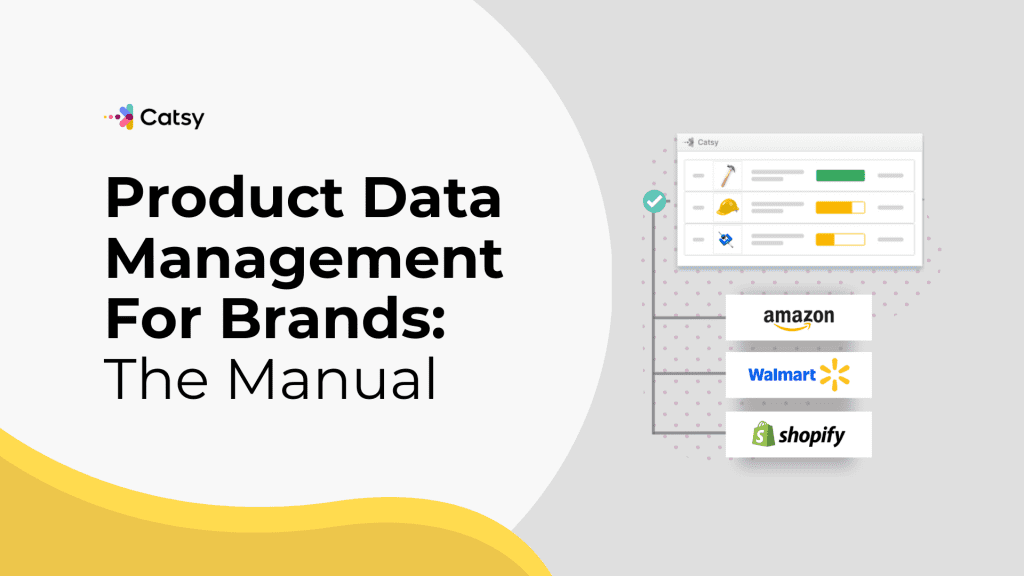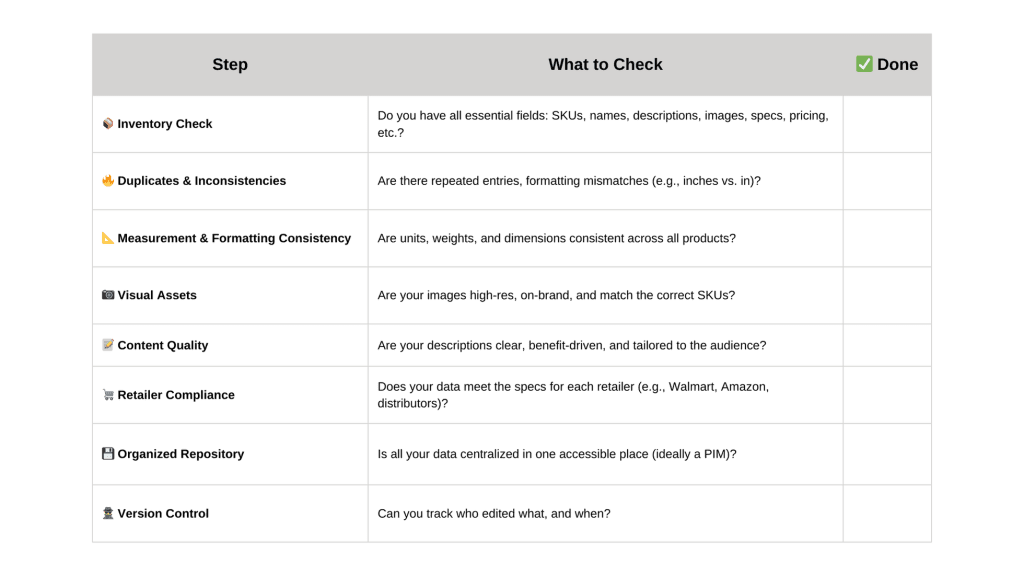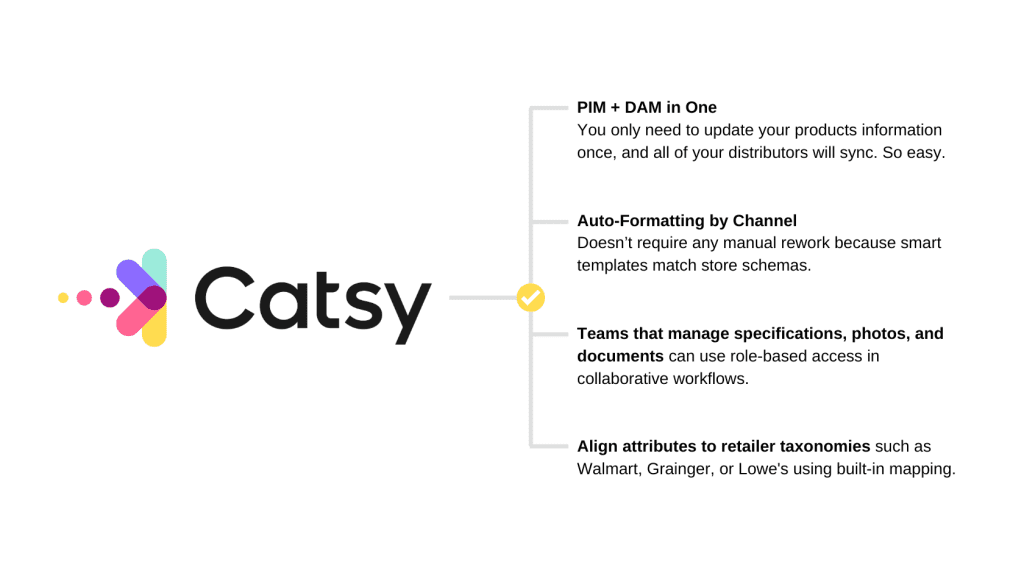Product Data Management for Brands: The Manual
After reading this guide, you’ll have a clear understanding of product data management for brands—how to get your content ready for Amazon, Walmart, Shopify, and more. We’ll break down every step, from enrichment to syndication.

Product Data Management for Brands
Getting your product data ready for retail partners might not be the flashiest part of your job, but it’s one of the most important, especially if you’re managing hundreds or thousands of SKUs across multiple platforms.
The way you prepare your product content may make or break your retail partnerships (and your sanity), whether you’re updating spec sheets, onboarding new products, or syncing data across Amazon, Walmart, Shopify, or BigCommerce. It quickly becomes overwhelming with complex formatting rules, spreadsheet overload, and last-minute changes from the sales team.
We created this guide for that reason. Helpful tips on what marketplaces and retailers truly require from you, how to maintain organization, and how a streamlined product workflow—ideally driven by a PIM—can save your team hours of time-consuming effort and avoid expensive mistakes.
Let’s break it down.
💡 This guide will teach you how to:
- Clean and organize product data prior to submission
- Avoid frequent syndication errors across marketplaces.
- Establish a retail-ready, scalable content process for DTC and multichannel commerce
- Deliver accurate data to Amazon, Walmart, Shopify & more.
In this Article
The Reason Clean, Retail-Ready Product Data Matters
Your product data must be complete, accurate, and ready to plug into their systems for retail partners to use it. If not, you may anticipate rejections and delays.
This is why it’s important:
- Incomplete compatibility data, low-quality images, or missing specifications result in confused customers and product returns.
- Strict formatting requirements apply to retailers. Walmart, and Amazon each have unique image, taxonomy, and template requirements.
- Speed to shelf is everything. Your competitors gain an advantage every day that your industrial SKU isn’t active.
Fact: Up to 30% of product listings are rejected by retailers because of inaccurate or missing information.
Your Retail Partners Look for This Information in Your Product Data
Each marketplace and retailer has its own internal data playbook, and no two are exactly the same. Hence, brands and suppliers must prepare for some common requirements.
| 📦 Category | 🔍What They Expect |
| Complete, Structured Data | – Product Titles (clear, keyword-rich, standardized) – SKUs & Identifiers (UPC, GTIN, EAN, etc) – Descriptions (short + long-form) – Specifications (materials, dimensions, weight, etc.) – Category Taxonomy (aligned with their format) – Bullet Points (scan-friendly features) |
| Retail-Ready Media Assets | – High-resolution images (clean background, no watermarks) – Lifestyle & Alternate Views – Product Videos (increasingly essential) |
| Channel-Specific Customization | – Custom image formats + counts – SEO-optimized titles per platform – Character limits + structure by channel – Compliance fields (e.g., safety, eco-labels) |
Make Catsy DAM and PIM Software an Extension of Your Team
Book a Free DemoMost Frequent Errors:
When handling product data at scale, even the most experienced brands make mistakes. These are the most common:
- Each channel uses a single master file. The solution is to make channel-specific templates using a PIM as your master source.
- Using different naming customs. You can try to standardize the names for sales channels, warehouses, and ERPs.
- Ignoring the metadata fields. Be careful to incorporate backend properties, compatible parts, safety warnings, and alt text.
- Not keeping track of updates. Make sure audit logs and version control are turned on for every data update.
- Not following style guides for retailers. The solution is to personalize checklists for each merchant and automate validation.
Prepare Your Data for Distribution:
- The first thing you need to do is to make a list of all the information you currently have, including SKUs, specifications, manuals, and visual assets.
- Once you get the list, check for duplicates and inconsistencies. Look for legacy characteristics and formatting problems.
- Let’s now confirm that retailers are complying. Making a matrix with the required fields for every merchant and noting any information that is missing is one method to accomplish this
- To improve your material, include spec diagrams, 360-degree photos, certifications, and bullet points.
- ⭐️ Recommended: Keep everything in one location. Try Catsy, a DAM and PIM system that helps you manage and syndicate product information effectively.
Try This Checklist: Audit of Product Data Before Launch

Retail Syndication for Industrial & Distributor Brands
- Products with a lot of specifications (tools, parts, machines)
- Variable logic products (size, voltage, material)
- Technical records (certifications, datasheets, and manuals)
Creating a Product Data Workflow That Is Ready for Retail
- Centralize Data – Integrate PIM and DAM to manage content in a single location.
- Enrich SKUs – Include detailed features, specs, and descriptions that are optimized for search engines.
- Verify Completeness – Before submitting, check for any gaps using the score and standards.
- Use the Format by Retailer option to create exports that are mapped to websites like Walmart, Amazon, and others, eliminating the need for manual uploads.
- Automate Syndication – Deliver clean data to every channel.
Yes, we are aware that this is a substantial amount of information. But don’t worry. This is how Catsy simplifies retail data syndication:

Remember…
Product data management for brands must be precise, enhanced, and retail-ready from the start, regardless of whether you’re listing tools, electrical components, or industrial-grade machinery.
Using a platform like Catsy you’ll launch more quickly on the distributor portals; decrease errors and listing rejections; and cultivate trust with end users and retail partners.
Want more tips, tutorials, and insights on product content and e-commerce operations?
Stay connected. We post regularly to help brands like yours scale smarter.
Are You Ready To streamline your product content management?
Continue Reading

Frequently Asked Questions
They include technical specifications, product descriptions, pricing, categorization data, product codes, product relationships (kits, accessories, etc.), regulatory/compliance data, product marketing content, rich media assets like images, videos, and 3D models, product documentation like manuals, and digital product renditions for e-commerce. Having a single source of truth for all this data prevents issues when distributing it to partners.
Inaccurate or incomplete product data flowing to distributors frequently leads to negative customer experiences in a few key ways: orders getting fulfilled with the wrong products, delays on orders, components missing from product bundles, sales staff’s inability to correctly market features, and customer returns and refunds due to products not matching expectations set by the product data. Customers get frustrated when their orders don’t match what was represented.
Industrial products are inherently complex, and the number of technical attributes that need to be accurately detailed is exponentially greater. There are complex specifications, product configurations, compatibility data, industrial certifications, product documentation, and more to account for. Any misstep in data accuracy could violate safety regulations or cause products to be unusable for their intended purposes. The room for error is far less.
Complete and accurate product data is essential for distributors to forecast demand correctly and set stocking levels to avoid stockouts or overstocks. They rely on data like product descriptions, pricing, product bundling details, and other marketing data to gauge customer demand. If crucial data elements are missing or wrong, it can completely throw off their sales projections and inventory planning. This leads to carrying costs or lost sales from not having the right products available.
A PIM centralizes and validates the core product details like technical specifications, descriptions, categories, etc. DAM software does the same for product-related media like photos, videos, documents, etc. When integrated, users can quickly map assets to corresponding product details in PIM to create enriched product experiences. This high-quality product data can be distributed to sales and marketing channels like distributor portals. The tight integration ensures consistent, high-quality product data and assets.
Subscribe For More Content
Sign up for monthly tips on how to drive revenue with product content.




